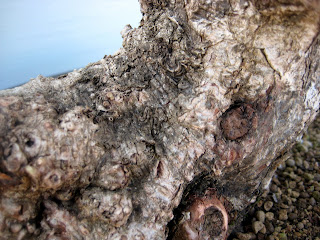On one side (pictured above), the negative is a large wound up about the middle of the trunk, but the taper is slightly more dramatic because of it and there is also nice taper to the root base. The collected Korean Hornbeam's typically don't have much of a root spread at the base, but rather a wood mass that has formed from all of the budding along the base of the trunk. There isn't much branching on this side of the tree, mainly because of the wound.
The other side has no large wounds to think of, and nice, even flowing taper to the apex. Plus, the apex branch has slightly better taper and secondary branching. This side also has a lot of branching, which I would need to thin if making it the front to expose the trunk line. Not a big deal, but I'd rather have these branches to the side/back and wire them to bring them to the front.
Quite the dilemma, huh? I chose the side with the wound. Why? Simple - the nebari rules all. The stronger nebari/base taper that flowed to the soil level made for the most appeal.
I began with cleaning out the wounds. As I chipped away at the layer of cut paste, I saw a black color to the bark, which meant the top layer of the exposed wound had begun to rot under the paste. I dug out the rotted layer using a chisel from this carving kit. In addition to carving out the rotted wood, I attempted to expose a new layer of cambium around the edge to induce healing again of the wounds. Ever since spending a day with Dan Robinson at his gardens in Washington, the use of my knob cutter has been dwindling. Dan swears against the tool all together. I only use the knob for real soft wood, generally Japanese or Trident maples. When working Hornbeam, I usually carve a short jin or stub, then use my carving tools to blend the wound using the adjoining contours of the tree. Since the newly exposed wood can be fairly bright, I usually burn the exposed wood to darken the color.
After all of the cleanup, it really came down to picking branches and wiring. The tree was heavy branched on the back side, so I brought one of these forward to create my first branch. I think the rest came together nicely and this should make a very nice bonsai in the years to come. I will change the planting angle slightly to hide the stubbed roots on the back side of the tree and plant this into a smaller, deep oval, come spring time.






